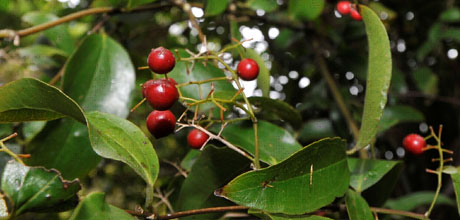From Forest Floor to Tree Top
This article was first published on 05 Jun 2012.

Ripogonum scandens
Whilst walking the Heaphy track many years ago I remember being shown a plant whose shoots would help sustain you if you were without water. The plant was a supplejack vine and the tender shoots, tasting a bit like a green bean, were certainly juicy. Fortunately I have never had occasion to rely on this knowledge for survival but it is something I remembered when coming across this plant as a horticulturist.
Supplejack, or kareao, is known botanically as Ripogonum scandens. It is a vine of lowland forests throughout the country and is quite distinctive. It has stems that are so dark in colour they look black and these can form quite a thicket. The leaves have an obvious pair of lateral veins each side of the midrib which also help to distinguish this climber.
Initially the dark twining stems arise from the forest floor, coiling around branches for support. Once these stems have reached sufficient light they produce non-twining stems bearing the leathery green leaves and inflorescences.
The flowers of supplejack are fairly insignificant, however the round red fruit are showy and make me think of jaffas. These can be present throughout the year but are not always obvious unless you’re looking up. Currently the bright red fruit can be easily seen at Dunedin Botanic Garden in the north tree & shrub border, adjacent to Lovelock Avenue, in the Native Plant Collection.
Supplejack grows naturally in the native bush areas of the New Zealand Native Plant Collection and Rhododendron Dell in the upper Botanic Garden.
Shirley Stuart is curator of the native plant collection at Dunedin Botanic Garden.


